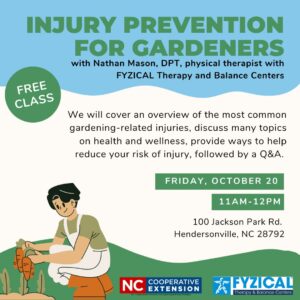Injury Prevention for Gardeners
go.ncsu.edu/readext?962476
en Español / em Português
El inglés es el idioma de control de esta página. En la medida en que haya algún conflicto entre la traducción al inglés y la traducción, el inglés prevalece.
Al hacer clic en el enlace de traducción se activa un servicio de traducción gratuito para convertir la página al español. Al igual que con cualquier traducción por Internet, la conversión no es sensible al contexto y puede que no traduzca el texto en su significado original. NC State Extension no garantiza la exactitud del texto traducido. Por favor, tenga en cuenta que algunas aplicaciones y/o servicios pueden no funcionar como se espera cuando se traducen.
Português
Inglês é o idioma de controle desta página. Na medida que haja algum conflito entre o texto original em Inglês e a tradução, o Inglês prevalece.
Ao clicar no link de tradução, um serviço gratuito de tradução será ativado para converter a página para o Português. Como em qualquer tradução pela internet, a conversão não é sensivel ao contexto e pode não ocorrer a tradução para o significado orginal. O serviço de Extensão da Carolina do Norte (NC State Extension) não garante a exatidão do texto traduzido. Por favor, observe que algumas funções ou serviços podem não funcionar como esperado após a tradução.
English
English is the controlling language of this page. To the extent there is any conflict between the English text and the translation, English controls.
Clicking on the translation link activates a free translation service to convert the page to Spanish. As with any Internet translation, the conversion is not context-sensitive and may not translate the text to its original meaning. NC State Extension does not guarantee the accuracy of the translated text. Please note that some applications and/or services may not function as expected when translated.
Collapse ▲Last week, Issac (Agriculture Program Assistant) and I spent some time cleaning up our yard and gardens here at the office, along with the help of of our wonderful NC State Extension Master Gardner℠ volunteers. With the changes of the season, we are pulling up old tomato plants, mulching our beds and even establishing some new native plants!
The day after our weeding, shoveling and planting, I was SORE. For many of us, gardening is an excellent way to spend time outdoors and can be therapeutic, but is it also a form of exercise and like any other type of exercise, poor form can lead to soreness and even pain over time. Muscles, tendons and nerves can all be affected by our activities in the garden and being proactive to avoid injury is how we can ensure that we can participate in the activities we love for years to come.
We are excited to be partnering with FYZICAL Therapy and Balance Centers of Hendersonville to offer a FREE class on injury prevention in the garden and how you can implement stretches and mindful movements to stay healthy and active! This class will be on Friday, October 20 from 11 a.m.-12 p.m. at our office, 100 Jackson Park Rd., Hendersonville, NC 28792.
Please register for this class using this Google Form
We will cover an overview of the most common gardening-related injuries, discuss many topics on health and wellness, provide ways to help reduce your risk of injury, followed by a Q&A.
Check out these helpful tips below for more info on injury prevention in the garden:
Adapt the Garden:
Create designs that promote healthy posture, movement, and maintenance. Examples include using raised beds and vertical gardens to avoid hunching over and kneeling; and appropriate placement of gardening elements, such as stepping stones and lightweight pottery that can be worked around without twisting, over-reaching, or pulling.
Adapt the Tools:
Use tools that are appropriate for the job and built for your needs and abilities. Examples include tools with ergonomic handles and attachments for gripping comfortably and keeping the wrist straight, and rakes and shovels with height-appropriate handles that help you maintain a straight back and avoid hunching over.
Adapt Yourself:
Assess your abilities, prepare properly, and utilize safe movements.
- Wear comfortable, breathable clothing and closed-toed shoes with ankle support. Even if it’s cloudy outside, put on sunscreen, a hat, and sunglasses if needed.
- Keep your tools and other essentials (trash bags, water bottle, cell phone, snacks, etc.) with you in a bucket or cart that travels with you while you work around the garden.
- Carry water with you and drink often. It’s best to drink water before gardening so you don’t start off dehydrated. Drink every 15-20 minutes while gardening, and drink water afterwards to help replace what you may have lost through sweat.
- Schedule tasks for cooler times of the day and break them into shorter activities. Try to avoid gardening for more than 1.5 hours at a time and incorporate the outlined suggestions.
- Change tasks every 20 minutes to something that utilizes alternate muscles and intensities (e.g., change to an activity that requires standing after kneeling). Or take a break altogether, stretch the muscles you used, and hydrate.
- Engage your leg muscles rather than your arms and back when lifting, carrying, and putting down items, changing directions, and moving back and forth (e.g., raking and shoveling).
- When working low to the ground, kneel rather than crouch or squat. Use a foam mat or knee pads to cushion your knees. Kneel on one knee while keeping the other foot on the ground for support. This helps avoid hunching while keeping your back straight. Alternate every couple of minutes.
- Stretch before, during, and after gardening. Gardening is considered a physical activity, so treat it the same way as any form of exercise. Warm up your muscles first before stretching. As you take breaks, stretch the used muscles. At the end, do whole-body stretches.
These are just a few ways to help minimize pain and prevent RSIs and other injuries from occurring in the garden. As with any activity, practice makes perfect! The more you practice these suggestions, the more they become a normal part of your routine.
Source:
Prevent Injury in the Garden with Proper Posture, Tool Use, and Stretches
By: Gabriela Murza, Professional Practice Extension Assistant Professor, Health and Wellness/HEART Initiative





